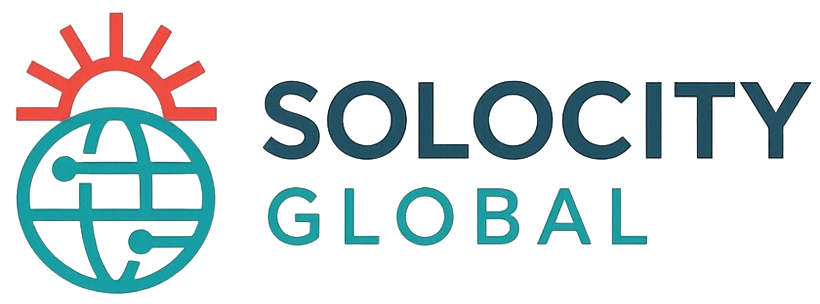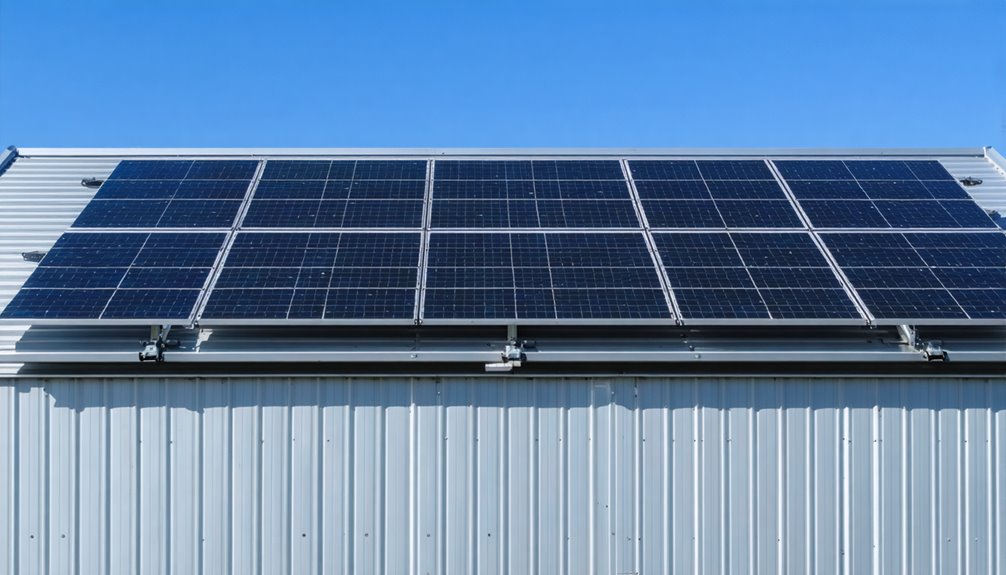You can efficiently mount solar panels on a metal roof without drilling by using advanced clamp-on systems and weatherproof adhesives. These non-invasive methods guarantee secure installation while preserving roof integrity, boasting benefits like weight distribution that eliminates the need for penetrations and structural damage. Additionally, specialized clamps approved by roof manufacturers provide durability against weather conditions. Weatherproof adhesives and regular inspections further stabilize installations, promoting efficient energy capture. Explore innovative techniques to maximize solar potential on metal roofs.
Understanding Non-Invasive Solar Mounting Systems
Adjustable clamps guarantee that different metal roof styles and solar panel sizes can be accommodated, offering flexibility in installation. This method allows for quicker installations, reduces labor costs, and minimizes risks of installation errors, promoting robust functionality with regular inspections. Additionally, thorough wind uplift assessments and ballast calculations are essential to ensure the stability and warranty compliance of non-penetrating mounting systems on metal roofs.
Benefits of Metal Roofs for Solar Installations
Metal roofs offer several significant advantages for solar installations, primarily due to their durability and longevity, with a lifespan ranging from 40 to 70 years, making them an ideal partner for solar systems intended to endure over time. Their non-invasive mounting systems efficiently enable you to install solar panels without risking leaks and preserving structural integrity. Moreover, the reflective properties of metal roofs enhance energy efficiency by keeping homes cooler, thereby reducing energy demands. This compatibility accelerates the installation process, lowering labor costs and minimizing installation errors. Additionally, metal roofs are recyclable and eco-friendly, appealing to sustainability goals commonly associated with solar energy systems. Their aesthetic charm also adds architectural appeal, providing a visually pleasing solution for homeowners committed to environmental responsibility. Their non-invasive mounting systems reduce penetrations and help maintain waterproofing integrity over the lifetime of the roof.
Exploring Clamp-On Systems for Solar Panels
When considering clamp-on systems for mounting solar panels on metal roofs, you’ll find they offer several benefits, including even weight distribution using specialized manufacturer-approved clamps, which preserve roof integrity and expedite installation without extensive drilling. These systems enhance design integration by maintaining the modern aesthetics of metal roofs while offering versatile compatibility through adjustable clamps that fit various roof profiles and panel sizes. Additionally, some clamp-on systems incorporate weatherproof adhesives alongside mechanical attachments, providing enhanced stability and durability against harsh weather conditions. This approach supports long-term performance by emphasizing material durability across different roof profiles and panel sizes durability.
Clamp-On System Benefits
How do clamp-on systems enhance the deployment of solar panels on metal roofs? These systems utilize specialized clamps approved by metal roof manufacturers, allowing you to install solar panels without causing structural damage. By distributing weight evenly, clamp-on systems eliminate roof penetrations, maintaining the roof’s integrity and aesthetic appeal. Installation is efficient and cost-effective since it involves minimal drilling, fitting seamlessly with various metal roof designs. Additionally, less maintenance is required compared to traditional methods.
| Feature | Benefit |
|---|---|
| Even weight distribution | Prevents structural damage |
| Seamless integration | Enhances aesthetic appeal |
| Minimal drilling required | Reduces installation time and costs |
While regular inspections are necessary, these systems protect your investment by extending your solar panels’ and metal roof’s lifespan.
Integrating Design and Technology
Building on the benefits of clamp-on systems for solar panel installation, the integration of design and technology in these systems offers a sophisticated solution for deploying solar panels on metal roofs. Specialized, manufacturer-approved clamps distribute the weight efficiently, reducing potential damage and leaks. This non-invasive approach enhances aesthetic appeal by seamlessly embedding the system into modern metal roof designs. Adjustable clamps cater to various roof profiles, ensuring that your solar installation is both visually appealing and structurally sound. With expedited installation processes, requiring minimal drilling, labor costs decrease while minimizing potential errors. Regular maintenance involves straightforward inspections of clamps and hardware, ensuring long-term performance and preserving structural integrity. This methodical, technologically integrated solution optimizes both the practicality and appearance of mounting solar panels.
Versatile Roof Compatibility
Many types of metal roofs, including standing seam, stone-coated steel, and corrugated profiles, can effectively support solar panel installations through versatile clamp-on systems. These systems allow you to mount solar panels without drilling, using specialized clamps approved by metal roof manufacturers. By distributing weight evenly, these clamps prevent potential damage and guarantee stability during wind and weather events. Adjustable clamps cater to various roof profiles and panel sizes, enhancing customization during solar mounting and installation efficiency. As non-invasive solutions, clamp-on systems maintain the roof’s warranty and structural integrity, eliminating risks like leaks. Additionally, the quick, flexible installation process reduces labor costs and minimizes errors compared to traditional methods, providing a practical approach to solar energy adoption on metal roofs.
Adhesive Solutions in Solar Panel Installation
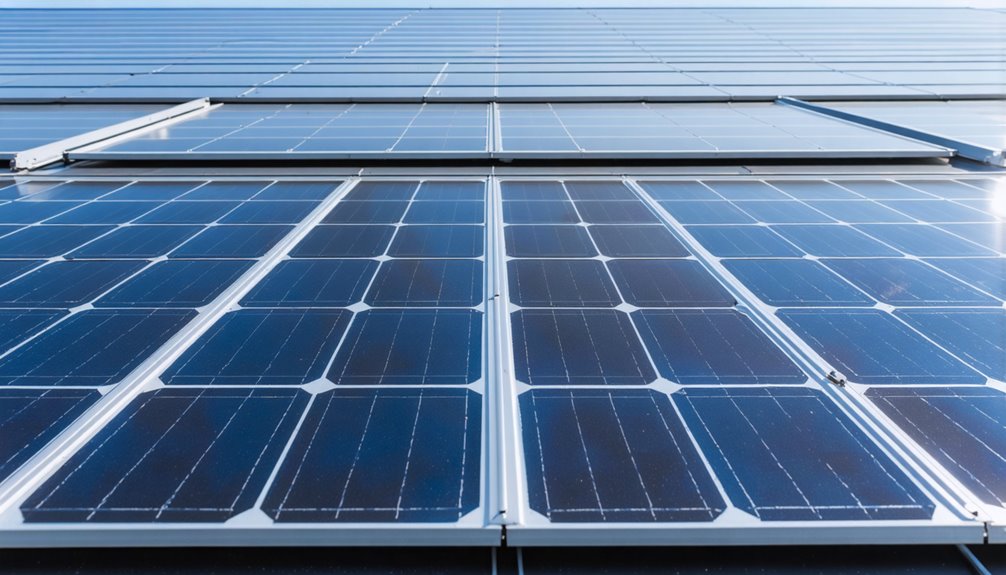
While traditional methods of solar panel installation often involve drilling into metal roofs—which can lead to potential integrity issues—there’s an alternative approach utilizing adhesive solutions that secure panels effectively. By applying weatherproof adhesives, you can achieve a strong bond, guaranteeing efficient weight distribution that prevents roof damage. This installation method helps in reducing time and labor costs, as it eliminates the complexity of equipment needed for traditional systems.
Across commercial installations, ballast mounting offers practical benefits for rapid deployment and roof preservation.
The following table outlines key benefits:
| Benefit | Description | Impact |
|---|---|---|
| No Drilling | Prevents roof integrity issues | Maintains roof longevity |
| Fast Installation | Reduces installation time and labor costs | Lowers overall project budget |
| Versatility | Compatible with various metal roof profiles | Suits different architectural needs |
Adhesive technologies, often paired with mechanical attachments, guarantee stability during extreme weather.
Step-by-Step Process for Non-Drilling Installations
Initiating a non-drilling solar panel installation on a metal roof demands a systematic approach to guarantee both efficiency and longevity. Begin by conducting a detailed roof inspection to evaluate its condition and compatibility with non-intrusive solar mounting systems. Use advanced design software to optimize the solar panel layout for maximum sun exposure. Secure non-invasive clamp-on mounting systems to the metal roof, ensuring the solar panels are safely anchored without the need for drilling, thereby preserving roof integrity. Enhance security by applying weatherproof adhesives in conjunction with mechanical fasteners, minimizing water ingress risks. Additionally, review local building codes and permit requirements to ensure code compliance with wind and snow load standards. Finally, carry out a thorough inspection to verify all mounting components’ proper installation and confirm the electrical systems’ functionality, ensuring the system operates efficiently before concluding your project.
Conducting a Solar Roof Inspection
Before commencing the non-drilling installation process, conducting a meticulous solar roof inspection is paramount to ensuring the metal roof is a suitable candidate for solar panels. Start by evaluating the overall condition of the roof, checking for rust, corrosion, or structural damage. Determine the specific type of metal roof (e.g., standing seam or corrugated) to decide on the appropriate roof mounting system. Measure the roof’s slope and orientation for ideal sun exposure, documenting these details to aid in the solar panel installation planning stages. Examine existing roof penetrations or seams to pinpoint potential installation challenges.
Here’s a concise summary of inspection points:
| Inspection Element | Description | Required Action |
|---|---|---|
| Roof Condition | Check rust, corrosion | Note any damage |
| Roof Type | Identify design | Select mounting system |
| Slope | Measure angle | Record data |
| Orientation | Evaluate sun exposure | Document findings |
| Roof Penetrations | Examine seams | Identify potential issues |
Designing Solar Layouts for Metal Roofs
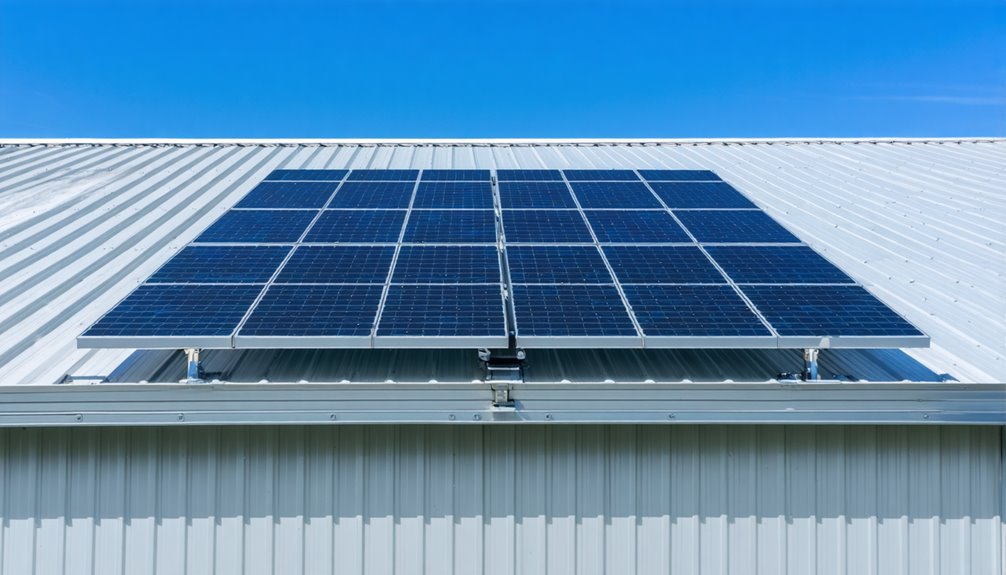
When you’re designing solar layouts for metal roofs, focus on optimizing sun exposure to guarantee your panels achieve maximum efficiency, which involves strategic consideration of panel orientation and tilt angles. By choosing non-invasive mounting systems, you can create flexible configurations that not only work with various roof profiles but also enhance the property’s aesthetic appeal, integrating seamlessly with the modern look of metal roofs. Remember to account for any potential shading from nearby structures or vegetation to maintain the high performance and efficiency of your solar installation.
Optimizing Sun Exposure
To enhance sun exposure when designing solar layouts for metal roofs, leveraging advanced software is crucial, as it allows for detailed analysis of roof orientation and shading patterns, guaranteeing maximum energy generation. Non-invasive mounting systems offer flexibility in panel arrangement, accommodating different roof styles and enhancing sun exposure. By considering your roof’s angles and slope, you can strategize to achieve efficient solar performance. Typically, a south-facing orientation captures the most sunlight during peak hours. Free roof inspections help identify sun-rich areas for strategic panel placement. Using adjustable clamps in your mounting system, you can adjust the solar panels precisely to amplify energy output while preserving roof integrity.
| Consideration | Benefits |
|---|---|
| Roof Orientation | Maximizes sunlight during peak hours |
| Shading Patterns | Prevents unnecessary shading and energy loss |
| Non-Invasive Mounting | Maintains roof integrity |
| Adjustable Clamps | Guarantees ideal panel angling |
| South-Facing Panels | Increases sunlight exposure and energy generation |
Aesthetic Integration Strategies
Integrating solar panels aesthetically on metal roofs requires meticulous planning and innovative mounting technologies that align with the roof’s unique design features. Employing non-invasive mounting systems is essential for achieving aesthetic integration. These systems, including clamp-on mounts and adjustable clamps, allow solar panels to blend seamlessly with various roofing styles, following the contours and profiles, thereby enhancing visual appeal. Non-invasive mounting not only preserves structural integrity but also supports flexible layouts, accommodating unique geometric designs without exposing hardware prominently. Thin-film solar laminates offer a sleek, unobtrusive alternative to traditional crystalline panels, facilitating fast installation and maintaining modern aesthetics. Incorporating solar panels into the roof’s design enhances stylistic coherence and may increase property value and curb appeal by merging contemporary architecture with renewable energy solutions.
Mounting Techniques to Protect Roof Integrity
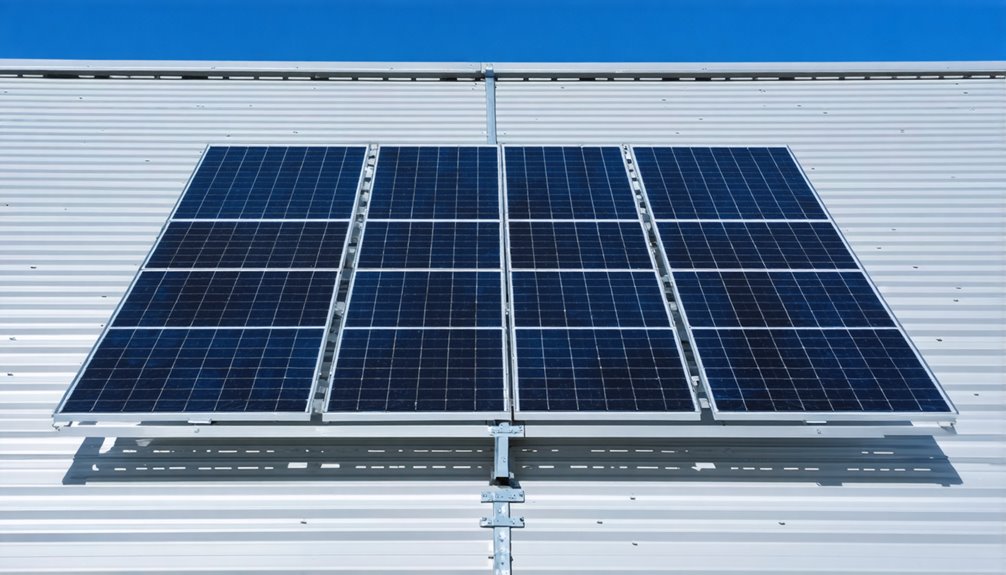
Employing non-invasive mounting techniques for solar panel installations on metal roofs is essential for preserving the roof’s structural integrity and warranty. Non-invasive mounting systems, such as clamp-on and adhesive solutions, are designed to circumvent the need for drilling, which can lead to leaks and structural issues, thereby protecting the roof’s integrity. Specialized mounting methods, particularly clamp-on systems, utilize adjustable clamps that distribute the solar panels’ weight evenly across the roof’s surface, preventing any single point of pressure or damage. These clamps can be adjusted for different roof profiles and panel sizes, ensuring a secure fit. Additionally, some systems incorporate weatherproof adhesives alongside mechanical attachments to enhance stability while maintaining the roof’s structure, ultimately extending the metal roof’s lifespan and ensuring its long-term utility.
Ensuring Electrical Compatibility and Safety
When implementing solar panels on metal roofs using non-invasive mounting techniques, verifying electrical compatibility and safety is critical to prevent hazard and inefficiency. First, it’s essential to maintain electrical grounding throughout the system. Proper grounding reduces electrical faults and verifies personal safety. Non-invasive mounting systems should employ anchor points and brackets that uniformly distribute panel weight, avoiding strain on the wiring, which could otherwise cause electrical failures. Additionally, using weatherproof adhesives not only secures solar panels but effectively seals connections, protecting against moisture that can lead to short circuits and corrosion. Verify all components, including inverters and wiring, are compatible with metal roofs to optimize energy conversion and prevent interference. These precautions are necessary for a reliable solar installation.
Regular Maintenance and Inspection Guidelines
To guarantee the ongoing efficiency and security of your solar panel installation on a metal roof, it’s essential to conduct regular inspections of the non-invasive mounting system, specifically focusing on the condition of clamps and mounting hardware to maintain structural integrity. Equally important is the frequent cleaning of the metal roof to remove debris that can obstruct solar panel performance and hinder effective water drainage. By paying close attention to these maintenance tasks, you’ll help prevent potential failures and prolong the life of both your roof and solar installation.
Inspect Clamps Regularly
It’s essential to regularly inspect the clamps and mounting hardware of solar panels every six months to maintain their security and prevent issues that could compromise the integrity of the installation. By inspecting clamps carefully in your non-invasive mounting system, you’ll guarantee they remain secure without signs of wear or corrosion. During each inspection, verify that the clamps are fastened to the correct torque specifications, as loosening might occur due to temperature fluctuations and wind loads. Additionally, monitor the positioning of the clamps to confirm they’re aligned correctly with the solar panels, preventing uneven stress. Document your maintenance checks and findings diligently; this record will help track the reliability of your setup and schedule future inspections more effectively, supporting long-term performance.
Debris Cleaning Frequency
Maintenance of solar panel systems on metal roofs requires regular debris cleaning to guarantee maximum energy efficiency and system longevity. You should perform debris cleaning at least twice a year to remove leaves, dirt, and other obstructions. In areas with heavy foliage or significant dust, increase the debris cleaning frequency to quarterly intervals, ensuring performance remains ideal. During each cleaning session, inspect the mounting systems and clamps to verify they are secure, installed quickly, and show no signs of corrosion or wear. Maintaining a debris-free roof surface not only enhances solar panel performance but also extends the lifespan of the mounting systems by preventing moisture buildup and rust. Utilize gentle, non-abrasive methods to keep panels and mounts intact and functional.
Addressing Aesthetic Concerns and Solutions
How do you maintain the visual appeal of a metal roof while integrating solar energy technology? Non-invasive mounting systems, like clamp-on solutions, offer an excellent approach to preserving aesthetic integrity and preventing potential leaks. These systems maintain the roof’s architectural design, enhancing visual appeal while avoiding the unsightly penetrations common with traditional installations. Seamlessly integrated with diverse metal roof styles, non-penetrating systems accommodate various designs and colors, ensuring solar panels complement rather than detract from the overall aesthetic. By using adjustable clamps that distribute weight effectively, these mounting options not only enhance aesthetics but also maintain structural stability. Homeowners have the flexibility to personalize their solar installations, achieving a cohesive look that aligns with individual style preferences and boosts property value.
The Role of Weatherproof Adhesives
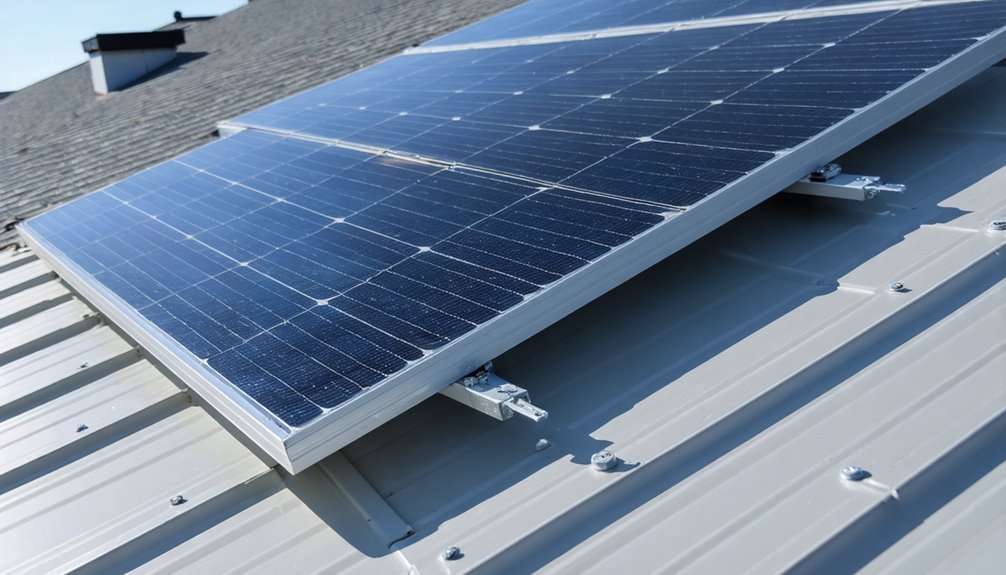
In preserving the aesthetic integrity of metal roofs during solar panel installations, the use of weatherproof adhesives provides an ideal solution by ensuring a secure, leak-free bond without the need for penetrative methods. These adhesives, engineered for durability, withstand extreme weather and maintain the stability of solar panels over time. By eliminating the need for drilling, they protect the roof’s structural integrity and preserve warranties, preventing potential future issues. Weatherproof adhesives, when paired with mechanical attachments, not only enhance the stability of the installation but also distribute weight evenly across the roof, mitigating damage risks. This method facilitates quicker installations and reduces labor costs, making it an attractive choice for those considering installing solar panels on metal roofs.
Comparing Thin-Film and Crystalline Panels
When considering the installation of solar panels on a metal roof, it’s essential to evaluate the characteristics of both thin-film and crystalline panels, as they each present unique benefits and limitations. Thin-film solar laminates are lightweight and flexible, allowing quick installation without penetration, seamlessly integrating with metal roofing due to their slim profile, though they typically offer lower efficiency and a shorter lifespan of around 10-15 years. Meanwhile, crystalline solar panels generate more energy and boast longer durability with warranties of 20-25 years, though they come with the trade-off of being bulkier and possibly detracting from the roof’s aesthetic. They often require additional structural support, potentially involving clamp-on systems, unlike adhesive solutions possible with thin-film options.
Non-Penetrating Systems: Innovation and Trends
As you explore the differences between thin-film and crystalline panels for solar installation on a metal roof, it’s important to contemplate the innovations in non-penetrating mounting systems that offer significant advantages. Non-penetrating systems, like the SolarPod Crown and S:FLEX Flat Direct, facilitate efficient solar array installations without drilling, maintaining the roof’s structural integrity. These systems distribute weight via specialized clamps or adhesives, preventing movement, minimizing leaks, and guarding against damage during extreme weather. The trend towards these solutions is fueled by homeowner demand for aesthetic, efficient, and minimally invasive solar installations, enabling faster installation times and reduced labor costs. Furthermore, these systems accommodate various roof shapes, such as barrel rooftops, enhancing flexibility compared to traditional methods.
Community Interest and Industry Impact
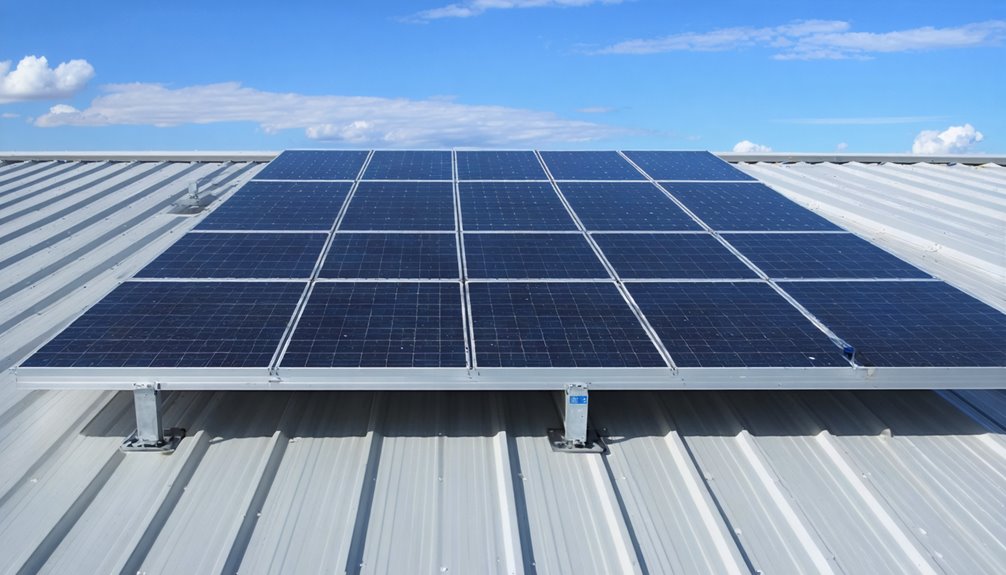
The increasing engagement from both homeowners and industry professionals in non-penetrating solar mounting systems underscores a collective shift towards more sustainable and efficient roofing solutions. As community engagement grows, homeowners express interest in systems like the Solar Pod Crown and S:FLEX Flat Direct, emphasizing logistical ease in installation and re-roofing processes. Such systems provide reassurance about maintaining the roof’s integrity while withstanding extreme weather. Industry impact is evident as events showcase a rising demand for innovative, non-invasive options tailored for diverse roofing. This demand motivates manufacturers to enhance their offerings, ensuring these systems meet certification standards in the U.S. market. These certifications are vital, boosting consumer and contractor confidence in the systems’ performance, reliability, and long-term benefits.
Conclusion
Incorporating non-invasive techniques, such as clamp-on systems and adhesive solutions, allows you to install solar panels on metal roofs without drilling, preserving structural integrity while optimizing energy generation. Weatherproof adhesives offer durability and resistance to environmental stressors, ensuring secure installations, while innovations in non-penetrating systems expand available options for metal roof applications.
These drilling-free mounting methods provide effective alternatives that maintain roof warranties and structural integrity while delivering reliable solar energy performance. Understanding the various technologies and their applications enables property owners and installers to select appropriate solutions based on specific roof configurations and environmental conditions.
For projects requiring high-quality mounting systems, Solocity Global serves as a trusted exporter of solar panel mounting solutions, providing standards-compliant products to clients across international markets. The company’s comprehensive range of mounting systems supports diverse installation requirements while meeting rigorous quality and safety standards worldwide.
